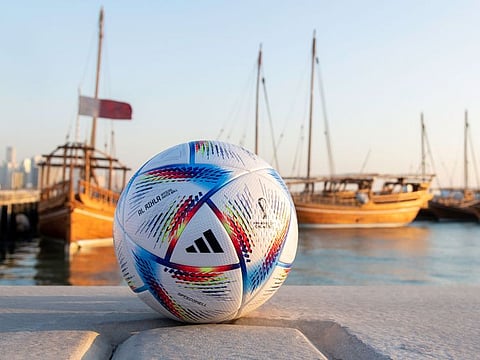Football: New World Cup ball Al Rihla promises to be the fastest and most accurate
Kaka and Casillas attend adidas’ unveiling of Al Rihla, official ball for World Cup Qatar

Adidas unveiled Al Rihla, which is said to be the fastest and most accurate World Cup ball, on Wednesday in Qatar. Al Rihla, the official match ball for the football World Cup 2022, was presented at an event near Doha, the Qatari capital. World Cup stalwarts Kaka of Brazil and Iker Casillas of Spain were at hand for the glittering show that featured football talents from Qatar, UAE, Saudi Arabia, Egypt.
The match ball show is the first of many activities in the runup to the Fifa World Cup Qatar 2022 that starts in November. From Doha, the Al Rihla will journey to 10 cities, including Dubai, Tokyo, Mexico City and New York, where adidas will launch new initiatives for local football communities.
The German sports goods giant, who created the 14th successive match ball for the World Cup, says the Al Rihla is designed to speed the games as “it travels faster in flight than any other World Cup ball.”
“The game is getting faster, and as it speeds up, accuracy and flight stability becomes critically important. The new design allows the ball to maintain its speed significantly higher as it journeys through the air,” said Franziska Loeffelmann, design director - Football Graphics & Hardwear, adidas.
Al Rihla is Arabic for “the journey”, and the ball’s design and colours are inspired by the architecture, boats, and flag of the host nation Qatar. “The vibrant colour and graphics set on a pearlescent background are inspired by the culture of Qatar and the ever-increasing speed of the game, with speed revealing the spectrum of colour to excite players and fans around the world from grassroots to elite levels,” adidas said.
The ball is the latest in the line of official match balls from adidas. Some of the well-known ones are Tango (1978), Tango Espanao (1982), Teamgeist (2006), Questra (1994), Jabulani (2010) and Brazuca (2014).
HISTORY OF WORLD CUP BALLS
■ There were no official match balls in World Cup till 1970. The balls were sourced from the home country or the kits of the teams playing the match. ■ The 1970 World Cup in Mexico is best remembered for Pele’s magic and Brazil’s third win which secured them the Jules Rimet Cup. The World Cup also had the first official match ball: Telstar, made by German sports goods manufacturer adidas. It was the first football made with a black and white pattern for increased visibility on television. ■ For the next 14 World Cups, adidas continued to create a new ball with newer technologies. Tango used in 1978 (Argentina) is said to be one of the best. ■ Tango Espana was the last genuine leather football used in a World Cup. It helped Paulo Rossi and Italy win in 1982 (Spain). ■ Jabulani appeared when the World Cup moved to South Africa in 2010. But the ball courted controversy after it became a goalkeeper’s nightmare. ■ Brazuca was the first match ball named by fans. That was when Brazil played hosts in 2014. ■ The original ball of 1970 was redesigned when it resurfaced as Telstar 18 for the 2018 football fiesta in Russia. It had an embedded near-field communication (NFC) chip. ■ Now comes Al Rihla, as the football showpiece comes to the Arab world, with Qatar hosting it in November and December.
According to adidas, Al Rihla has been designed from the inside out using data and rigorous testing at labs, in wind tunnels and on the pitch. The ball is expected to provide high accuracy and reliability, partly due to its new panel shape and surface textures. It is also the first World Cup ball made using only water-based inks and glues, the manufacturer said.
”For the biggest global stage in all of sport, we set out to make the impossible possible with radical innovation by creating the fastest and most accurate FIFA World Cup ball to date,” adidas’ Loffelmann added.
According to adidas, 1% of Al Rihla’s net sales will go to the Common Goal, a movement that helps “drive social change and support grassroots football communities worldwide”.
Sign up for the Daily Briefing
Get the latest news and updates straight to your inbox



